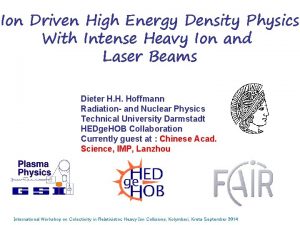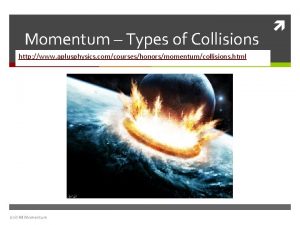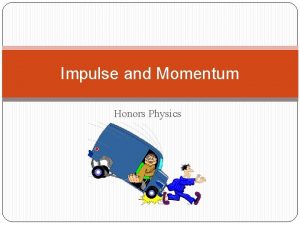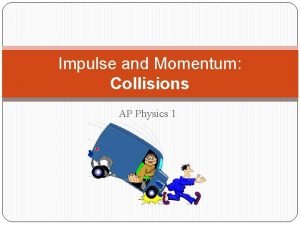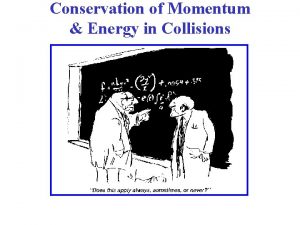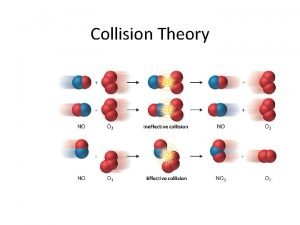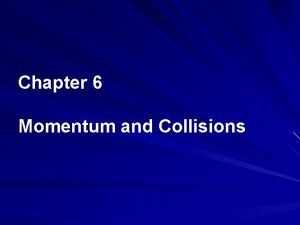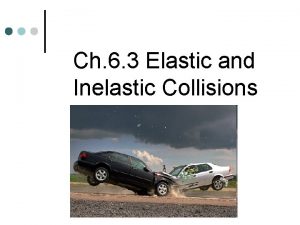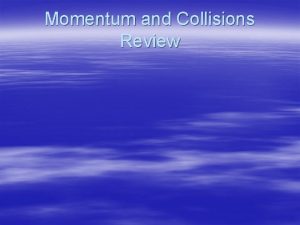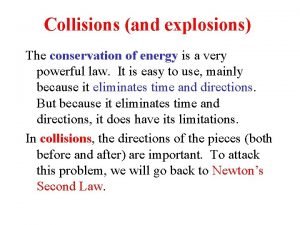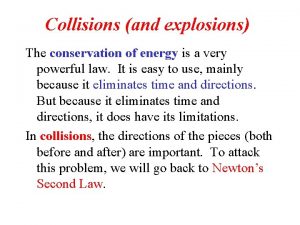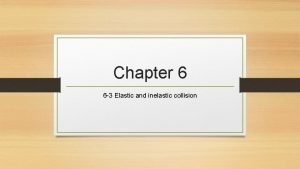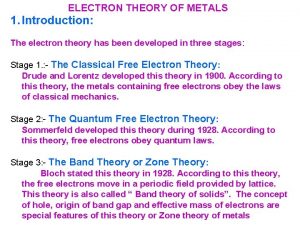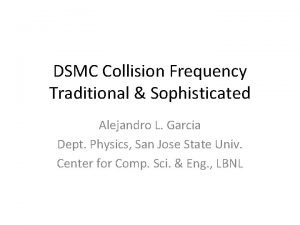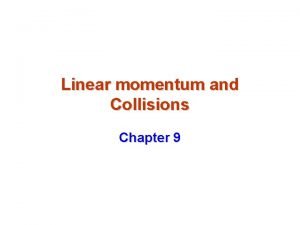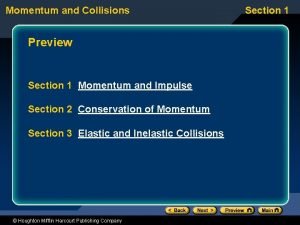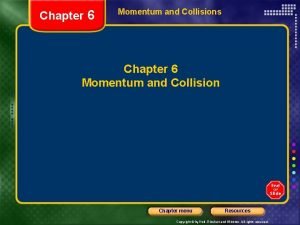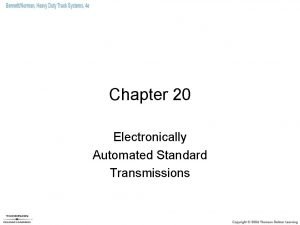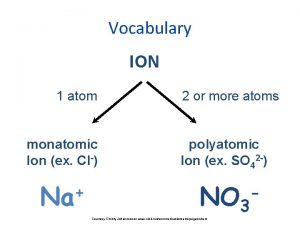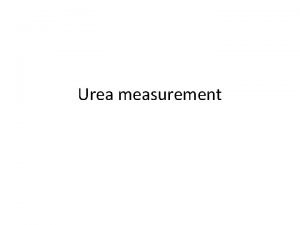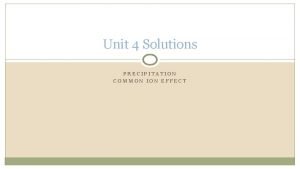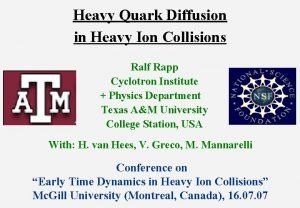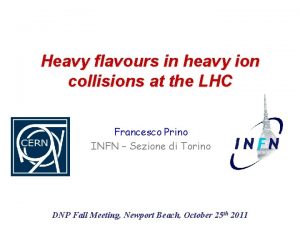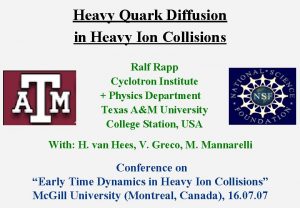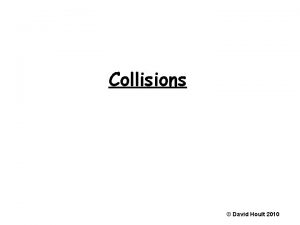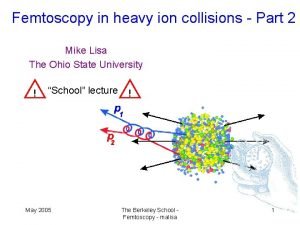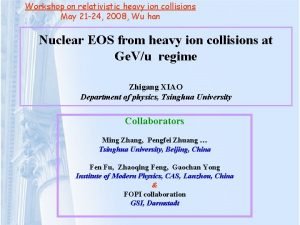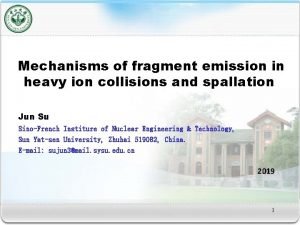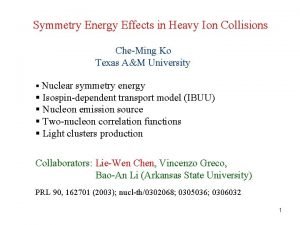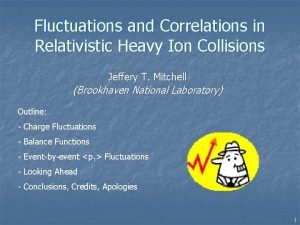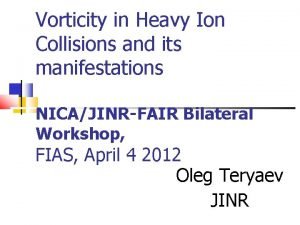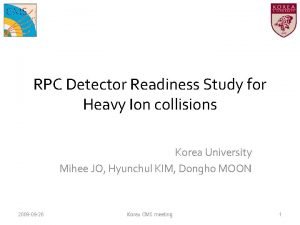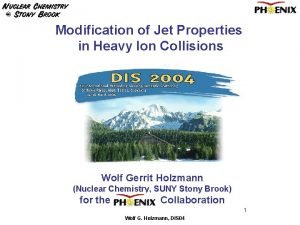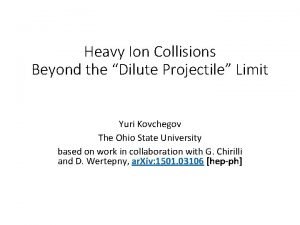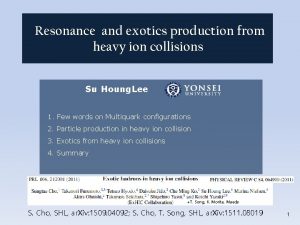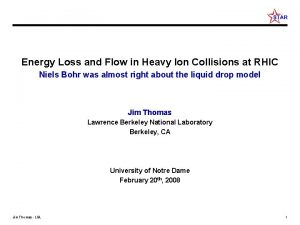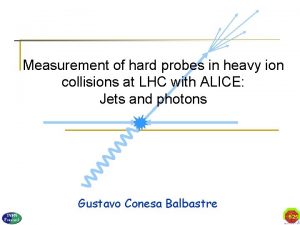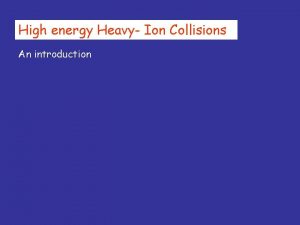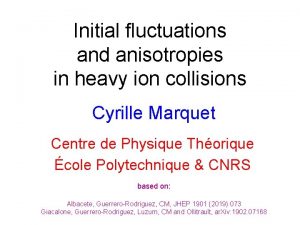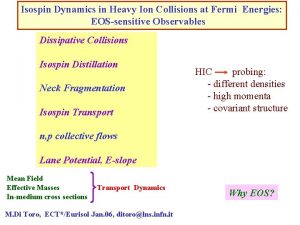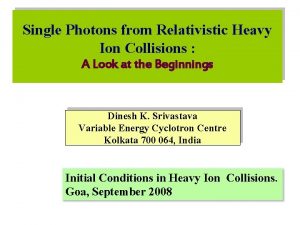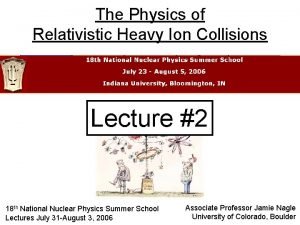Heavy multiquark systems from heavy ion collisions Su









![Newly observed states JPC Special feature QSR tetraquark X(3872) 1++ B(X Jppp)/B(X pp)=1 [AV][S] Newly observed states JPC Special feature QSR tetraquark X(3872) 1++ B(X Jppp)/B(X pp)=1 [AV][S]](https://slidetodoc.com/presentation_image/a6c738c3555872174f6d115b62b9c5d2/image-10.jpg)

![QCD sum rules X(3872): SHL, K. Morita, M. Nielsen (PRD 08) Ø J=[s][V] Tetraquark QCD sum rules X(3872): SHL, K. Morita, M. Nielsen (PRD 08) Ø J=[s][V] Tetraquark](https://slidetodoc.com/presentation_image/a6c738c3555872174f6d115b62b9c5d2/image-12.jpg)

























- Slides: 37

Heavy multiquark systems from heavy ion collisions Su Houng Lee 1. Few words on light Multiquark States and Diquarks 2. Few words on heavy Multiquark States and Sum Rules 3. Few words on New Predictions and Future Search 1

Recent Highlights in Hadron Physics – Heavy quark sector Babar: DSJ(2317) 0+ Puzzle in Constituent Quark Model(2400) 1. DK threshold effect 2. Chiral partner of (0 - 1 -) 3. Tetraquark molecule ? D 0 D* D 1 1864 2007 2420 D 0+D* D*+D* D+D 1 D 1+D* 3871 4014 4284 4427 X(3872), Y(4260), Z(4430) y’p Z(4051), Z(4248) cc 1 p Z(4248) ? Tetraquark ? Must contain cc ? S H Lee 2

Previous Work on Multiquark hadrons - Light quark sector Scalar tetraquark (Jaffe 76) p 1(1400) Candidate for Search for H dibaryon S H Lee Search for Q+ pentaquark 3

Light Multiquark states and diquarks S H Lee 4

Tetraquarks: Jaffe Ø color spin interaction: light scalar nonet Ø Diquark configurations Ø Scalar nonet |9, 0+> q 1 q 3 q 2 q 4 • Diquark basis • Q-anti. Q basis S H Lee 5

p 1(1400) E 852 + Chung et al. Ø p-wave decay of p 1(1400) into h p hp I=1 part of Flavor 10+10 Ø flavor Angular mom Total Anti-sym 1 (anti-sym) Symmetric eijk hnj pmk quark content of 10+10 • Can not be obtained from QQ • Can be obtained from (QQ): such as (3 X 6) + (3 X 6) Needs further experimental work S H Lee 6

Recently observed heavy Multiquark states (qqcc) F. Navara, M. Nielsen, SHL: PLB 649, 166 (07) SHL, M. Nielsen et al: PLB 661, 28 (08) SHL, K. Morita, M. Nielsen: PRD 78, 076001 (08), NPA 815, 29 (09) SHL, M. Nielsen, U. Wiedner: JKPS 55, 424(09) S H Lee 7

Recently observed states at B-Factory Through B decay s c Wc b Through ISR process e Belle: PRL 98, 082001 (07) c c e+ e- J/y + X(3904) D D* e+ S H Lee 8

Newly observed states JPC Observation mode confirmation X(3872) 1++ B+ X(3872 )K+ J/yp+p. K+ Belle, Ba. Bar, CDF, D 0 PP, X J/y g (c=+) Y 1–- Belle [V][S] q=s m=4. 65 q=u, d m=4. 49 Ds 0 Ds* m=4. 42 D 0 D* m=4. 27 DD 1 m=4. 19 (Nielsen, et al) (Nielsen et al ) g. ISR Z+(4430) ? , 0 - 4260, 4360, 4660 Ba. Bar 4260, 4360 y’ p [PS][S] m=4. 52 Special feature prediction B(X Jppp)/B(X Tornqvist DD* pp)=1 molecular state Hybrid D*D 1 m=4. 40 (Nielsen, Lee et al ) (Nielsen, et al) Z+(4050, 4250) S H Lee ? cp D*D* m=4. 15 DD 1=4. 19 (Nielsen, et al ) D*D*(4020) D 1 D(4285) threshold effect 9
![Newly observed states JPC Special feature QSR tetraquark X3872 1 BX JpppBX pp1 AVS Newly observed states JPC Special feature QSR tetraquark X(3872) 1++ B(X Jppp)/B(X pp)=1 [AV][S]](https://slidetodoc.com/presentation_image/a6c738c3555872174f6d115b62b9c5d2/image-10.jpg)
Newly observed states JPC Special feature QSR tetraquark X(3872) 1++ B(X Jppp)/B(X pp)=1 [AV][S] m=3. 92 (Nielsen. . ) (Nielsen, . . ) Y 1–- Belle [V][S] q=s m=4. 65 q=u, d m=4. 49 Ds 0 Ds* m=4. 42 D 0 D* m=4. 27 DD 1 m=4. 19 (Nielsen, et al) (Nielsen et al ) g. ISR Z+(4430) ? , 0 - 4260, 4360, 4660 Ba. Bar 4260, 4360 y’ p [PS][S] m=4. 52 QSR molecule DD* m=3. 87 Others QSR with G (Morita) , Mixture with cc Hybrid D*D 1 m=4. 40 (Nielsen, Lee et al ) (Nielsen, et al) Z+(4050, 4250) S H Lee ? cp D*D* m=4. 15 DD 1=4. 19 (Nielsen, et al ) D*D*(4020) D 1 D(4285) threshold effect 10

QCD sum rule results sum rule Ø Large M 2 Small M 2 In principle QCD can not distinguish between diquark configuration and molecular configuration Ø but if the overlap is large, plateau and OPE convergence, pole dominance S H Lee 11
![QCD sum rules X3872 SHL K Morita M Nielsen PRD 08 Ø JsV Tetraquark QCD sum rules X(3872): SHL, K. Morita, M. Nielsen (PRD 08) Ø J=[s][V] Tetraquark](https://slidetodoc.com/presentation_image/a6c738c3555872174f6d115b62b9c5d2/image-12.jpg)
QCD sum rules X(3872): SHL, K. Morita, M. Nielsen (PRD 08) Ø J=[s][V] Tetraquark current vs. J=DD* Molecular current Small width <2 Me. V S H Lee 12

Cont- Z(4430) : SHL, K. Morita, M. Nielsen (PRD 08) Ø J=D 1 D* Molecular current width = 40 Me. V S H Lee 13

Cont- Z 2(4250) : SHL, K. Morita, M. Nielsen (PRD 08) Ø J=D 1 D Ø But J=D* D* S H Lee Molecular current gives Mass>4. 2 in sum rule ? 14

Why not Tetraquarks Ø color spin interaction: q 1 H S H Lee q 3 H q 1 q 3 q 2 q 4 q 1 H q 2 H 15

Some predictions on Heavy and Explicitly exotic Heavy Multiquark states (qqcc) S H Lee SHL, S. Yasui : EPJC 64 283 (09) SHL, S. Yasui, W. Liu, CM. Ko : EPJC 54 259 (08) 16

Multiquark configuration: Mulders, Aerts, de Swart PRD 80 Ø S H Lee color spin interaction: light scalar nonet u d u d u s u u u s 17

Diquark inside Baryons Example d u s S H Lee u d s Mass diff MD –MN MS-ML MSc-MLc MSb-MLb Formula 290 Me. V 77 Me. V 154 Me. V 180 Me. V Experiment 290 Me. V 75 Me. V 170 Me. V 192 Me. V 18

quark antiquark in Meson p d u d Mass diff Mr –Mp MK*-MK MD*-MD MB*-MB Formula 635 Me. V 381 Me. V 127 Me. V 41 Me. V Experiment 635 Me. V 397 Me. V 137 Me. V 46 Me. V Works very well with u S H Lee r d u 3 x CB = CM = 635 mu 2 x 3= d u 19

Stable Multiquark configurations in a schematic diquark model S H Lee 20

Multiquark configuration: Multers, Aerts, de Swart PRD 80 Ø Diquark attracation vs quark-antiquark q 1 q 3 q 2 Ø diquark picture: Yasui, Lee, . . (EJP 08, EJP 09) Type of diquark and its q-q binding S=C=0 (ud) A S=-1, ms=5/3 mu (us) 3/5 A (ds) 3/5 A C=1, mc=5 mu (uc) 1/5 A (dc) 1/5 A S H Lee (sc) 3/25 A 21

Tetra-quark - configurations Binding against decay = (Mass of 2 Mesons) – (Mass of Tetraquark) 0+ 0+ S H Lee u u d d d c u b 0 - 0 - u u d c 0 - 0 - d d u b 22

Tetra-quark – hadronic weak decay modes 1+ S H Lee u d c c 0 - u c 1 - d c 23

Previous works on Tcc Z. Zouzou, B. Silverstre-Brac, C. Gilgnooux, J Richard (86), D. Janc, M. Rosina (04), Y. Cui, S. L. Zhu (07) QCD sum rules: F Navarra, M. Nielsen, SHLee, PLB 649, 166 (2007) simple diquark: SHL, S. Yasui, W. Liu, C Ko EPJ C 54, 259 (2008), SHL, S. Yasui: EPJ C (09) in press Can look for 1+ (Tcc) Belle: PRL 98, 082001 (07) e+ e- J/y + X(3904) e D D* c c c Tcc (3800) c e+ SHL, S Yasui, W Liu, C Ko (08) S H Lee 24

Pentaquarks (states with two diquarks ) QQs 1/2 - S H Lee D L u d u Q s u d Q u s 25

Di-bayron – general considerations S=C=0 (ud) -A S=-1, ms=5/3 mu (us) -3/5 A (ds) -3/5 A C=1, mc=5 mu (uc) -1/5 A (dc) -1/5 A di-baryon 1 B 3 2 0+ 5 (sc) -3/25 A 4 1 2 3 4 5 6 B B Conf-1 6 1 2 3 S H Lee B 6 4 Conf-2 5 26

Di-bayron (Conf 1) – (qq) H di-baryon 0+ u d u s u d s 2 SC like state CFL like state H di-baryon could be bound unfortunately not found in elementary processes S H Lee 27

Di-baryon (Conf 2) – (qq) (q. Q) Hc di-baryon 0+ u d u Xc P s u d u u s u c c Hc di-baryon new prediction could be found in heavy ion collision S H Lee 28

Some prediction for Heavy Ion 1. Large number of c and b quark produced 2. Vertex detector 3. High density matter: favors multiquark production 4. Example: FAIR S H Lee 104 / Month D 0 k- p+ SHL, K. Ohnishi, Yasui, In-Kwon Yoo, C. M. Ko: PRL 100, 222301(08) SHL, S. Yasui, W. Liu, C. M. Ko: EPJ C 54, 259 (08) 29

Success of Coalescence model = Statistical model + overlap Suppression of p-wave resonance (Muller and Kadana En’yo) PT dependence of ratio Ko et al S H Lee Quark number scaling of v 2 Ko et al v 4 Ko et al 30

Multiquark production in a simple coalescence model S H Lee RHIC (Au+Au) LHC (Pb+Pb) Nu=Nd 245 662 Nc 3 20 VC (fm 3) 1000 2700 Nu/Vc (fm-3) 0. 245 31

Production ratios for predicted Multiquarks Qc production at RHIC and LHC Ø Qc/D > 0. 74 x 10 -4 Qc/Ds > 0. 23 x 10 -3 Hc production at RHIC and LHC Ø Hc/D > 0. 8 x 10 Hc/Ds > 0. 25 x Ø 10 -3 Tcc production Tcc/D > 0. 34 x 10 > 0. 8 x S H Lee -4 10 -4 RHIC -4 LHC 32

Summary 1. 2. QCD sum rule analysis suggests that recently measured X, Y, Z most likely exotic states Diquarks are unique features of QCD, Mutltiquark states will exits in Heavy sector, due to diquark structure Tcc (ud cc) Qcs (udusc), Hc(udusuc)… RHIC, LHC can be a very useful heavy exotic factory � If found, it will be the first exotic ever, � will tell us about QCD, q-q interaction and dense matter � great step forward in QCD 3. If diquarks exists near Tc, additional production of Tcc and Qcs. Lc/D enhancement can be a signature of s. QGP � LHC plans to measure Lc and D, But all can be measured at KEK and J-PARK 4. S H Lee Multiquark states are doorway to dense QCD. 33

Back ups S H Lee 34

Hadronization through coalescence L: c / D ratio u c u D meson production through 2 -body coalescence of diquark and c suppressed S H Lee d c s u d c u u s u c c d d c c d s u u d d u u s u c Lc production through 3 -body coalescence d d d c Lc production through 2 -body coalescence 35

diquark – anti-diquark (Tetra-quark) - II S=C=0 (ud) A S=-1, ms=5/3 mu (us) 3/5 A (ds) 3/5 A C=1, mc=5 mu (uc) 1/5 A (dc) 1/5 A Z(4248) ? 1 - S H Lee (sc) 3/25 A L=1 u c L=1 d c 0 - u c 0 - c d 36

Pentaquark – general considerations S=C=0 (ud) -A S=-1, ms=5/3 mu (us) -3/5 A (ds) -3/5 A C=1, mc=5 mu (uc) -1/5 A (dc) -1/5 A L=1 Q+ u d 1/2+ (sc) -3/25 A P u d K d u s L 2 contribution - 500 Me. V in Full quark model by Hiyama, Hosaka et al Q+ 1540 can not be a pentaquark state, if it exists ? S H Lee 37
 Ejemplo de fuerza ion ion
Ejemplo de fuerza ion ion Fuerzas dipolo dipolo ejemplos
Fuerzas dipolo dipolo ejemplos Uniones intramoleculares
Uniones intramoleculares Force de london
Force de london Heavy ion
Heavy ion Ratey method
Ratey method Aplusphysics momentum-conservation answer key
Aplusphysics momentum-conservation answer key Elastic collision
Elastic collision Types of collision
Types of collision Impulse and momentum ap physics 1
Impulse and momentum ap physics 1 To avoid collisions a defensive driver should
To avoid collisions a defensive driver should In an inelastic collision what is conserved
In an inelastic collision what is conserved Elastic collision vs inelastic
Elastic collision vs inelastic Diagram of collision theory
Diagram of collision theory Momentum and collisions
Momentum and collisions Types of collisions
Types of collisions Momentum and collisions review
Momentum and collisions review Collisions and explosions
Collisions and explosions Collisions and explosions
Collisions and explosions Types of collision
Types of collision Is momentum conserved in all collisions
Is momentum conserved in all collisions Velocitation means
Velocitation means Drawbacks of free electron theory
Drawbacks of free electron theory Collisions
Collisions To avoid collisions a defensive driver should
To avoid collisions a defensive driver should Prévention des collisions engins-piétons
Prévention des collisions engins-piétons Collisions equation
Collisions equation Collisions
Collisions Chapter 6 momentum
Chapter 6 momentum Heavy duty truck systems
Heavy duty truck systems Heavy duty truck systems
Heavy duty truck systems Decision support systems and intelligent systems
Decision support systems and intelligent systems Engineering elegant systems: theory of systems engineering
Engineering elegant systems: theory of systems engineering Embedded systems vs cyber physical systems
Embedded systems vs cyber physical systems Elegant systems
Elegant systems Monatomic ion
Monatomic ion Diacetyl monoxime reaction with urea
Diacetyl monoxime reaction with urea Common ion effect example
Common ion effect example




